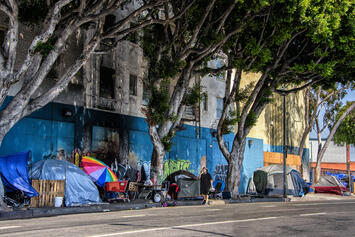
For generations, California has led the world in creating cutting-edge ideas and opportunities for newcomers. As actor-turned-governor of California Arnold Schwarzenegger once said:
‘We are the modern equivalent of the ancient city-states of Athens and Sparta… Not only can we lead California into the future… we can show the nation and the world how to get there.’
Today, the Golden State once again foreshadows the future, but this time it should be read as a warning.
Many still see California as the home of a ‘new progressive era’. It is often viewed as an exemplar of social equity, one that reflects, as a New York Times column put it, ‘the shared values of our increasingly tolerant and pluralistic society’. In truth, far from embodying an egalitarian ethos, it is pioneering a new kind of almost feudal society. A relative handful of oligarchs and a vast bureaucratic ‘clerisy’ lord it over a massive class of what are essentially serfs.
California is not only home to by far the highest number of billionaires in the US. But it also suffers the highest proportion of Americans living in poverty and the widest gap between middle- and upper-middle-income earners of any state. It endures among the US’ highest rates of unemployment, as well as massive net outmigration, an exodus that has increased sharply since 2019. It also has 30 per cent of the nation’s homeless population, with some now living in ‘furnished’ caves.
The key to understanding California’s neo-feudal reality lies in its changing economy. A decade ago, its largest firms included a host of aerospace, finance, energy and service firms. Today, the energy firms have largely disappeared – Chevron remains, though it has been moving more operations to Houston, Texas. Only one top aerospace firm, SpaceX, is still headquartered there, and it has also moved many operations to Texas. As Jerry Brown, who was governor of California for 16 years in two different periods, once warned, the state has a precarious ‘Johnny one-note’ economy. It is based almost entirely on returns to real estate, tech IPOs and the value of privately held ‘unicorn’ startups.
Even as fortunes are made by a handful of tech investors and entrepreneurs, most industries are stagnating or on their way out. Joseph Vranich and Lee Ohanian, in a Hoover Institution report released last year, observed that in 2020, Texas had seven times the number of company-initiated capital projects as California. Additionally, from 2018 to 2021, 352 companies headquartered in California moved their headquarters elsewhere.
The damage has been particularly severe in blue-collar sectors. This has proven a disaster for working-class Californians. Even without adjusting for costs, no Californian metro area ranks in the US top 10 in terms of well-paying, blue-collar jobs. But four – Ventura, Los Angeles, San Jose and San Diego – sit among the bottom 10.
For the majority of Californians today, most jobs are of a distinctly peasant quality. Since 2008, the state has created five times as many low-wage jobs as high-wage jobs. Even in Silicon Valley, once a byword for ambition and innovation, most new jobs earn less than $50,000 annually. That is far below what is needed to live a decent life in this ultra high-cost area. According to the Brookings Institution, San Francisco, arguably America’s premier high-tech city, has experienced the most rapid growth in inequality from 2007 to 2012.
Read the rest of this piece at Spiked.
Joel Kotkin is the author of The Coming of Neo-Feudalism: A Warning to the Global Middle Class. He is the Roger Hobbs Presidential Fellow in Urban Futures at Chapman University and and directs the Center for Demographics and Policy there. Learn more at joelkotkin.com and follow him on Twitter @joelkotkin.
Photo: Downtown Los Angeles, by Russ Allison Loar via Flickr CC 2.0 License.












